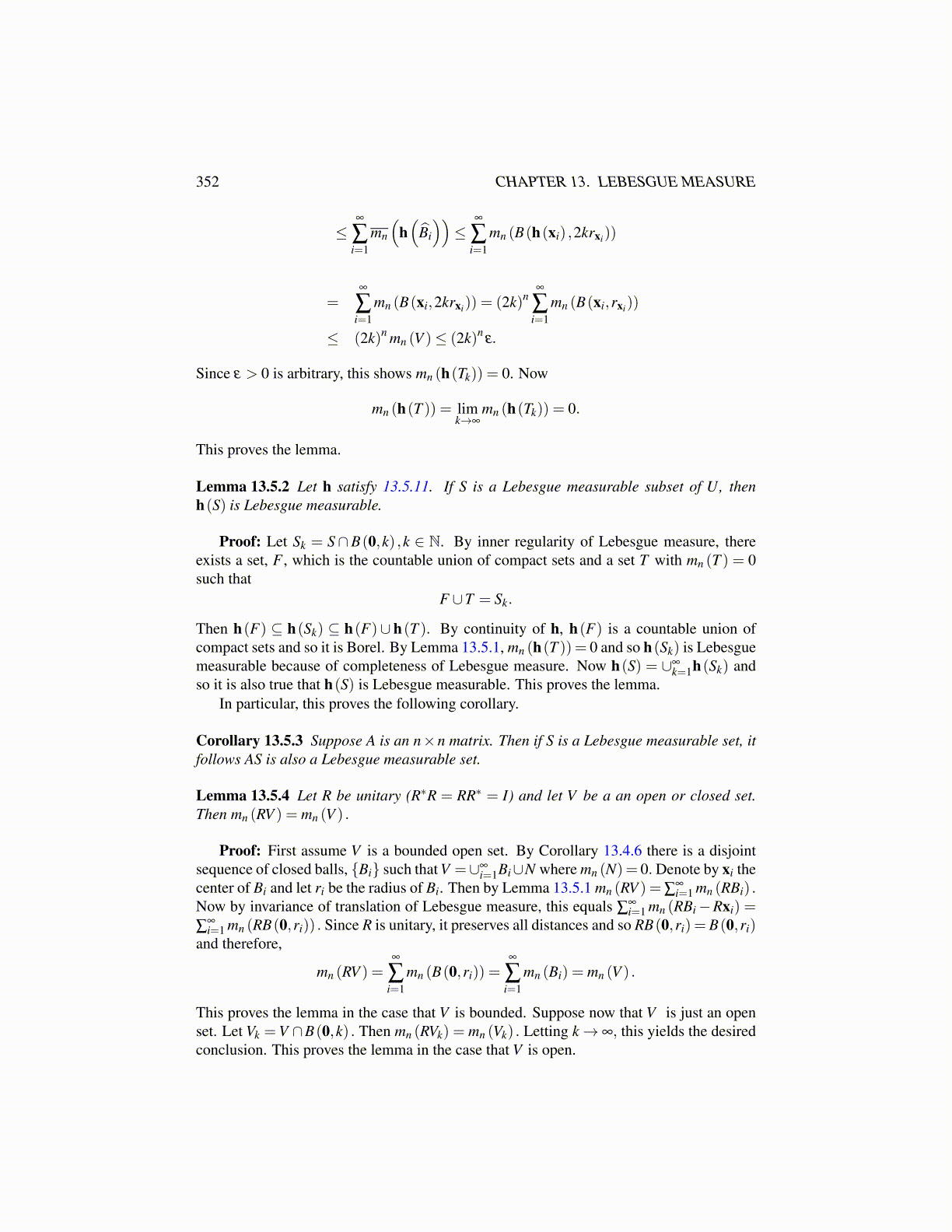
352 CHAPTER 13. LEBESGUE MEASURE
≤∞
∑i=1
mn
(h(
B̂i
))≤
∞
∑i=1
mn (B(h(xi) ,2krxi))
=∞
∑i=1
mn (B(xi,2krxi)) = (2k)n∞
∑i=1
mn (B(xi,rxi))
≤ (2k)n mn (V )≤ (2k)nε.
Since ε > 0 is arbitrary, this shows mn (h(Tk)) = 0. Now
mn (h(T )) = limk→∞
mn (h(Tk)) = 0.
This proves the lemma.
Lemma 13.5.2 Let h satisfy 13.5.11. If S is a Lebesgue measurable subset of U, thenh(S) is Lebesgue measurable.
Proof: Let Sk = S∩B(0,k) ,k ∈ N. By inner regularity of Lebesgue measure, thereexists a set, F , which is the countable union of compact sets and a set T with mn (T ) = 0such that
F ∪T = Sk.
Then h(F) ⊆ h(Sk) ⊆ h(F)∪ h(T ). By continuity of h, h(F) is a countable union ofcompact sets and so it is Borel. By Lemma 13.5.1, mn (h(T )) = 0 and so h(Sk) is Lebesguemeasurable because of completeness of Lebesgue measure. Now h(S) = ∪∞
k=1h(Sk) andso it is also true that h(S) is Lebesgue measurable. This proves the lemma.
In particular, this proves the following corollary.
Corollary 13.5.3 Suppose A is an n×n matrix. Then if S is a Lebesgue measurable set, itfollows AS is also a Lebesgue measurable set.
Lemma 13.5.4 Let R be unitary (R∗R = RR∗ = I) and let V be a an open or closed set.Then mn (RV ) = mn (V ) .
Proof: First assume V is a bounded open set. By Corollary 13.4.6 there is a disjointsequence of closed balls, {Bi} such that V =∪∞
i=1Bi∪N where mn (N) = 0. Denote by xi thecenter of Bi and let ri be the radius of Bi. Then by Lemma 13.5.1 mn (RV ) = ∑
∞i=1 mn (RBi) .
Now by invariance of translation of Lebesgue measure, this equals ∑∞i=1 mn (RBi−Rxi) =
∑∞i=1 mn (RB(0,ri)) . Since R is unitary, it preserves all distances and so RB(0,ri) = B(0,ri)
and therefore,
mn (RV ) =∞
∑i=1
mn (B(0,ri)) =∞
∑i=1
mn (Bi) = mn (V ) .
This proves the lemma in the case that V is bounded. Suppose now that V is just an openset. Let Vk =V ∩B(0,k) . Then mn (RVk) = mn (Vk) . Letting k→ ∞, this yields the desiredconclusion. This proves the lemma in the case that V is open.